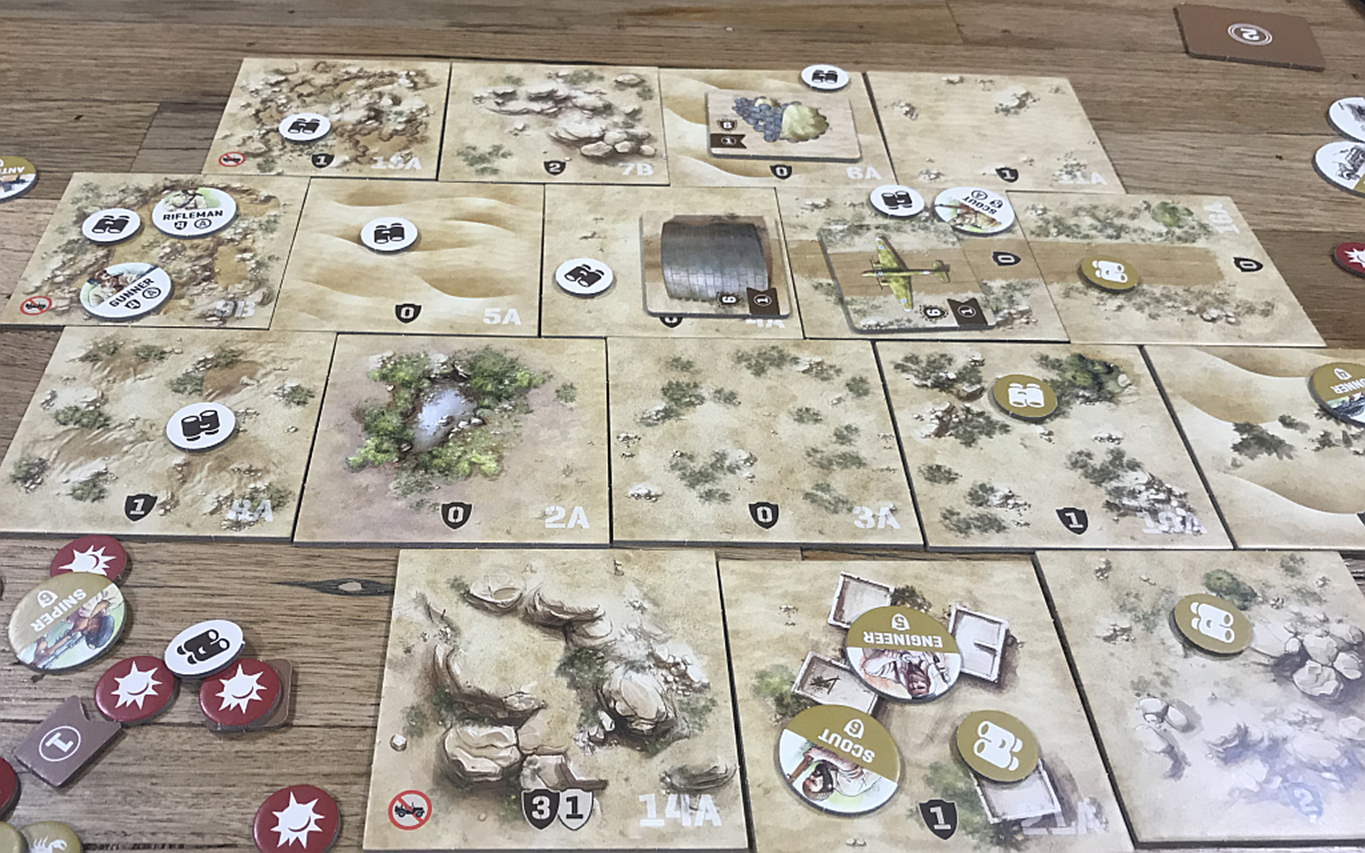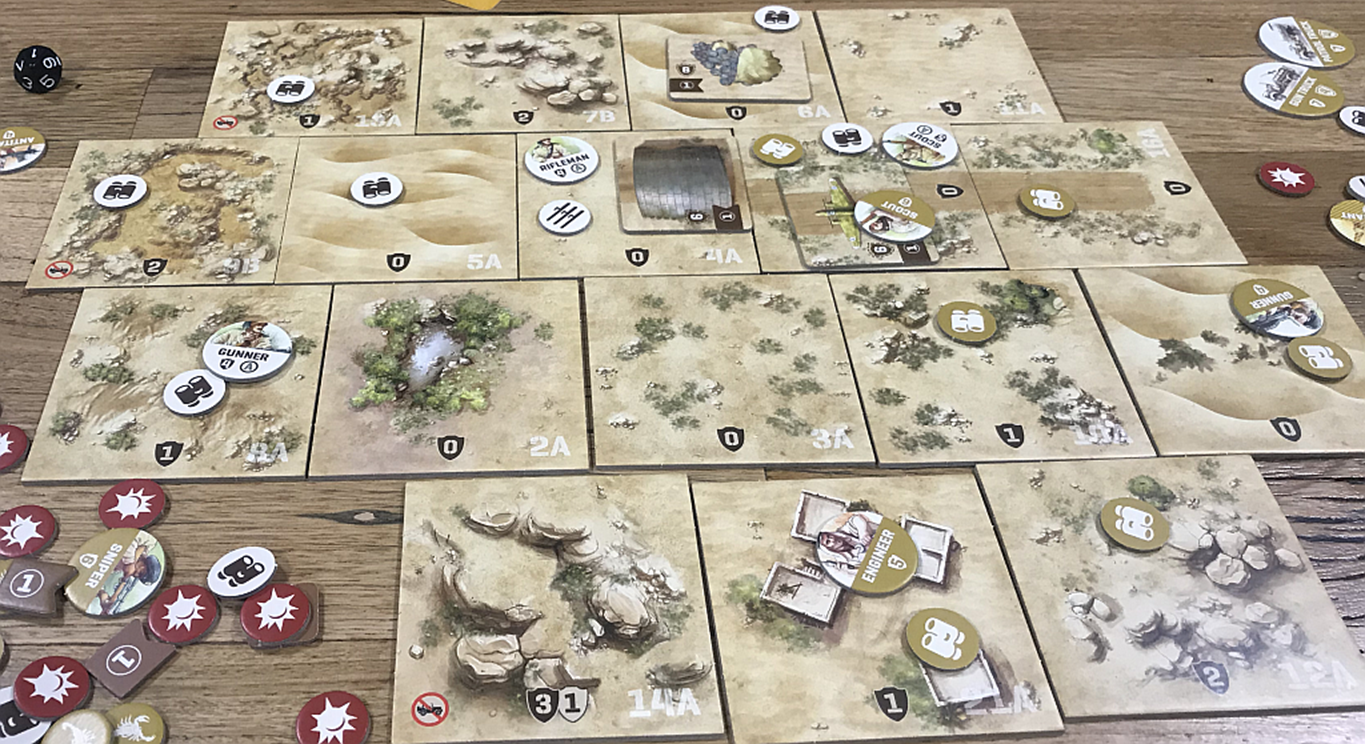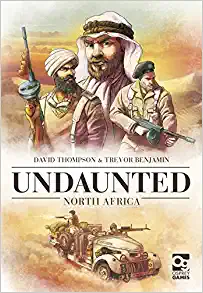The British LRP (Long Range Patrol) came across an Italian fuel dump and airstrip and attacked, seeking to destroy it. A few Italians stood between them and victory. This engagement is the first scenario in Undaunted: North Africa, a deck-building war game designed by David Thompson and Trevor Benjamin.
Unlike most historical wargames, each counter on the map represents a single soldier. The objective of this scenario for the LRP is to destroy 3 VPs worth of structures. The Italians need to control 3 VPs worth of structures. There are only 5 VPs worth of structures on the map, and obviously the Italians cannot control a structure that is destroyed.
My opponent this game is Mikey, who has never played the game before. I have played one game solo. I take the Italians, as the feedback I have read says they have trouble winning.

The opening moves of this engagement have both Mikey and I using our scouts to go forward and – ahem – scout the path to the objectives. With this game, you cannot move most troops onto a tile until you explore it first. In this opening scenario, only the scout has that capability. However, each tile you explore adds a “dead” card to your deck – a Fog of War – which means you will draw it later and have it clog up your hand. Scouts can also get rid of Fog-of-War cards, but that is a turn in which they do nothing else.
Mikey’s LRP went south first towards the 2 VP truck. My scout went east towards the airfield.
Each of us has only three soldiers for this introductory game: I have a machine gunner, a rifleman, and a scout. Mikey has a scout, an engineer, and a machine-gunner.
If the scout dies before it explores all the VP hexes, there is no replacement. Only my rifleman can control tiles; only Mikey’s engineer can destroy structures. So if we lose either of those, we are in trouble.
Mikey began to bring his engineer up to get to the truck. With the defensive bonus of the terrain he was in (+2), his innate defense (5) and the range (+5), I needed a 12 on a 10-sided die to hit him. This seemed unlikely.

Our initial decks had one of each of the unit cards, and two fog-of-war cards. We also each had two leader cards which were not represented by tokens on the board. Whenever a unit was struck, one of its cards was removed from the game. If we had no more cards of that type when it was hit, the token would be removed. An additional three of each of the units sat in a supply, which the leaders could be add to our decks. As we drew the leaders, we started “bolstering” our troops.
Apart from making them more resilient to damage, it also gave them more opportunities to act. A unit card has several options on it for actions; you can do one of them with that unit when you play the card. With my scout having explored all the tiles I needed, it was time to bolster my Rifleman and bring it up to control everything.
However, Mikey was bolstering his engineer, and before I could start moving my rifleman, he came up to the truck and set the charges. The engineer gets 3 ten-sided dice with the demolition action but must be on the same hex. If any of the dice rolled beat the defense value of the truck, the action is successful. With a defense of six and three d10s? Mikey destroyed it!

I moved my machine-gunner south to – with luck – be able to take better shots at Mikey’s engineer. Unfortunately, it was still a nine or ten to hit – which was bad odds, even as I tried suppressing it with four dice.
Suppression does not damage the token, but flips it over, and the next time a player tries to use the token, it just flips back and becomes active again, but skips that turn.
I likewise moved my Rifleman up towards the first objective and gained control of it. Mikey’s scout came up to open a path for the engineer to approach. He only needed one more VP!

However, there was one other problem: My rifleman was quite exposed, and Mikey was drawing a lot of Scouts and Gunners. He started attacking the Rifleman. Note that there is no line-of-sight in this game. You can attack anywhere you want on the map. The rifleman is also very weak – only a four defense. And it was not like there was anywhere to hide – the objectives all stood on 0 cover terrain.
So, LRP’s machine-gunner and scout attacked. And attacked. And attacked some more.
I bolstered to get my last remaining rifleman card into the deck, but Mikey’s next attack destroyed that as well. My rifleman might still be alive, but I could not activate him.
At that point, it became impossible for me to win. By the rules, we then compared victory points – as Mikey’s LRP had 2 points to my 1, Mikey immediately won!
And that was the end of my first game of Undaunted: North Africa with another player. Total playing time (including rules explanations and set-up): about 25 minutes. I think this scenario significantly favours the LRP as the Rifleman is very vulnerable to elimination. Let us see how the next scenario goes!
And yes, it was a fun game. The mechanics are easy to understand and use.


